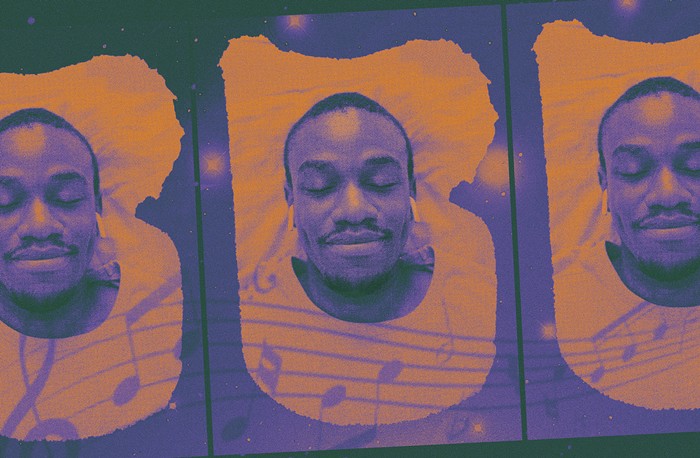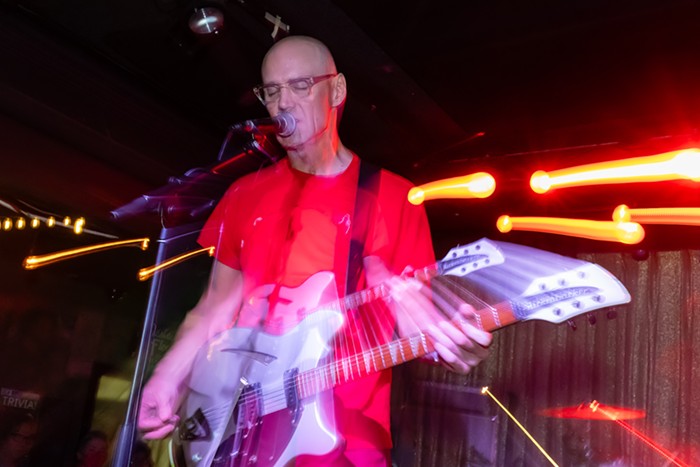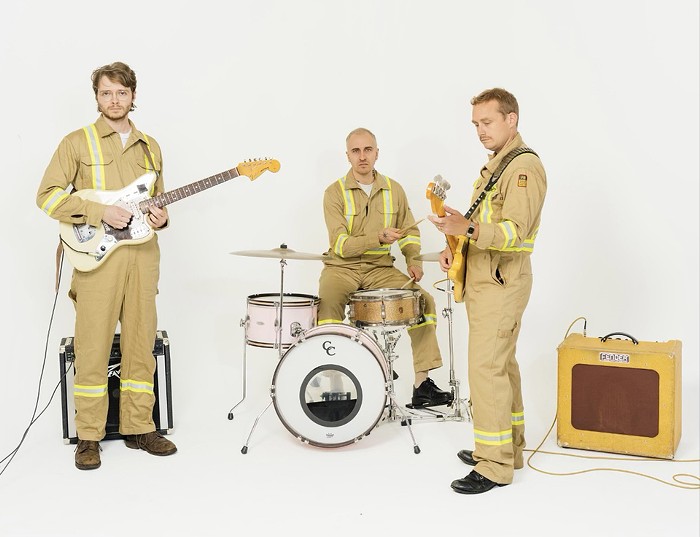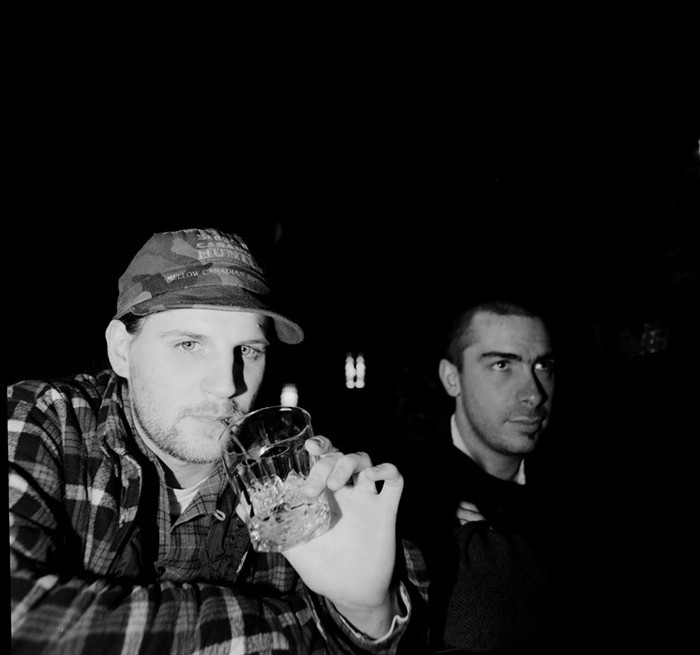From the outside, the house doesn't look haunted. Robert Lang's whitewashed, concrete and brick villa seems more suited for the Spanish coast than the Seattle suburb of Richmond Beach. Lang's home is also one of the Northwest's premier recording studios, and inside is the proof of a successful music career: walls hung with framed gold records by Nirvana, Dave Matthews Band, Death Cab for Cutie, Damian Marley, and Candlebox.
It isn't on public display, but Lang has evidence of less corporeal visitations as well: a photo of a ghostlike apparition, stories of inexplicable gear failure, and colleagues willing to offer testimony. The legend of Robert Lang Studio goes beyond the historic recording sessions that have happened here (the last for Nirvana, the first for the Foo Fighters) and into the realm of the supernatural.
Lang is a smallish, excitable man with a spray of gray stubble on his chin, intense eyes, and a wry smile. On a glaring autumn day, he and engineer Justin Armstrong are hosting Hills of Elysium, a gothy Seattle rock band recording their debut album. The band exit the "live room"—the studio on the bottom floor—so Lang can point out exactly where he dug up a mysterious bag of money 30 years ago and, two years ago, where a photographer snapped a shot of the ghost that haunts the place.
The live room is the only place in the labyrinthine, four-story building with a palpably mysterious air. It's an oddly angled chamber built of slabs of marble and granite, with a 20-foot-tall ceiling. Lang, an able craftsman and electrician, cut and laid the stone himself and installed the electric candelabras that flicker a dim orange. Except for the drum kit in the corner and the electric guitars leaning against the wall, the room could pass for a well-decorated mausoleum. The heavy stone construction—softened by rugs on the floor and baffles on the ceiling—offers terrifically resounding acoustics; it's a drummer's dream, an asset that makes Robert Lang Studio so desirable.
We're standing in the middle of the room, in the exact spot where the ghost hovers in the infamous photo. Asked if he has an idea of the possible identity of the spook in the photo, Lang answers quickly. "There's no doubt about it," he says. "It's Dubby."
In 1975, this place was just a grassy suburban hillside and Lang was a Seattle native in his mid-20s. He owned the hillside and a home and more modest studio across the street, but dreamed of building a high-end studio in this sleepy bedroom neighborhood with a long, wide view of Puget Sound.
It was a freewheeling time. Lang says he was at a house party on Capitol Hill where he met Walter Westley Leonard—everyone called him Dubby—and the two bonded over their love of music and Harley-Davidsons. They hung out together at Lang's house and recorded whatever bands came their way. Dubby was a drifter who spent time in Hawaii and skippered yachts around Seattle, including, for a while, Bill McCormick's of McCormick & Schmick's.
In September of 1979, Lang says, Dubby told him about a stash of money he buried, cash squirreled away to move the current studio into bigger digs and establish a second studio on Orcas Island. "I knew there was money," Lang says. "He had already bought this house on 10 acres on the north side of Orcas Island. This was money to buy the MCI consoles that we were going to install in the studios." The money might've been illicit; Dubby's father, according to Lang, ran bootlegged liquor across the border during Prohibition, and Dubby received an allowance check from his mother at the beginning of every year.
At this point in their friendship, Dubby was staying with some mutual friends in the rural town of Twisp. He was unfocused, Lang recalls—"going through emotional problems—he was just somebody else"—and Lang wanted to help get him back on track.
After a particularly hungover morning, he took Dubby out to breakfast at the bowling alley in Richmond Beach. "We came back and he got in his RX-7 and I remember he put one of those aquarium thermometers on his forehead," Lang says. "He goes, 'Bobby, what am I reading?' and I say, 'You're reading fucked up, dude. Don't go.' He says, 'I gotta go; I'll see you later,' and he took off."
Two days later, on September 20, Dubby was dead. His was the quintessential rock-star departure: After too much to drink, he passed out and choked on his own vomit. Parts of Lang's story are vague and improbable, but it's his gospel, and he sticks to it.
Lang had lost a dear friend, someone he loved like a brother. But he couldn't help thinking about the stash of money. "In the back of my mind I knew there was something buried in the ground," he says. A few weeks after the funeral, he bought a metal detector. He searched in the lot across the street for a month, looking for Dubby's loot. He found nothing. Then he realized that his intent was wrong.
"I was like, the only thing that makes perfect sense is if I'm digging for this recording studio, if I'm sweating and I'm digging and I'm sweating and I'm dirty," Lang says. So he started digging the foundation for his studio. Weeks passed, then months. He hadn't uncovered Dubby's stash, but at least he was getting somewhere with the construction. Then came the fateful night.
"It was pouring down rain and I had this little orange trouble light hanging on the sewer line," Lang recalls. "I'm digging on the north side of the plot, and the sand sloughs. All of a sudden appears this big plastic canister, just the edge of it. I'll never forget this: I looked at it and time just stopped."
The canister was filled with $100 bills. Lang refuses to divulge the grand total, but he says "it was a lot of money." Adhering to what he believes would've been Dubby's wishes, Lang sunk the cash back into the studio. "I prayed up to Dubby: 'Dubby, I will fulfill your dreams,'" he says, "because I knew that's what this was for."
In the intervening years, there have been numerous "occurrences," according to Lang and his associates. They attribute them to Dubby, visiting the studio from beyond the grave. Musicians and technicians have reported weird chills, strange noises, open doors that were closed before. "Everybody," Lang says, "every engineer that has worked here—every one of 'em—has come in contact with a supernatural phenomenon. Probably the coolest thing that happened—which I was really kind of happy about—was with the band Afghan Whigs."
The one-time Sub Pop signees were overdubbing songs for their Black Love album at Robert Lang Studio in the fall of 1995. The band had been hearing strange noises and a tape machine had broken down without warning—the explanation is complex, but repeated calls to the manufacturer stumped technicians. Two nights in a row, engineer Steve Culp woke up Lang with phone calls, asking him to come to the studio and assuage the band. The second time, Lang says, he arrived to find singer Greg Dulli with a fearful look on his face. A friend of Dulli's—a medium—had been in the house and declared supernatural forces at work.
Whigs bassist John Curley says his memory of the sessions have dulled with time, but he does recall strange goings-on, enough to convince the band a medium was a good idea. "Greg's friend came over and did her thing," which included burning sage to cleanse the space, Curley says. "After that, there were no more occurrences that I was aware of. She told us that spirits can sometimes manifest through electrical systems, which is why lights will flicker and tape machines go crazy." Curley remains uncertain about the tape machine and the medium's intervention. "What happened there was odd, but I wouldn't go as far as to say it proves anything. Certainly the place has that kind of vibe, even for someone who'd consider himself a skeptic."
For the skeptics, Lang offers the photo, taken by the drummer for the band Drown Mary in 2005. It depicts the band's bassist playing in the live room. His expression is intent; he's oblivious to the blurry visage that hovers above him. It's similar to the figure in the Edvard Munch painting The Scream.
The photo was taken through the glass door to the live room. "The face" could be a coincidence, a smudge or reflection on the glass. Lang insists otherwise.
"The vocalist was, you know how metal is, yarling—rararara—that kind of thing," he says. "Dubby—I don't think he approved of what was going on. In the picture, you can see his mouth like this [Lang widens his mouth into a silent scream], almost like he's going, 'No!'"
Lang seems comfortable inside his haunted house—almost proud. Despite his familiarity with the ghost, he's still spooked on occasion. "You could not pay me to walk through that studio when it was dark," he says.
The coda to Lang's story is even more bizarre: Lang has a slab of Italian marble that contains the image of Jesus Christ standing on the Mount.
He was cutting the marble to lay in one of the rooms of the house when he saw a flash of white light and the image made itself clear to him. Like recognizing shapes in passing clouds, seeing the image of Christ in the stone's green and white whorls requires some imagination. Lang has shown the marble to several ministers around the Midwest and Seattle; some are impressed by what they see. In a letter dated March 15, 1994, Reverend Roger O'Brien of St. Luke's Parish wrote, "For a Christian, it is hard not to see here a radiant figure of the risen Lord."
For the past several years, Lang has brought the slab with him to Mexico, where he resides most of the year. During Easter celebrations, he loans it to the Catholic church of Puerto Vallarta, Our Lady of Guadalupe, where pilgrims view it as a religious icon. "I don't make a habit out of going to church," Lang says, "but yeah, I believe in Christ."
John Curley of the Afghan Whigs has a measured perspective on Lang: "He seems like an enthusiastic guy about everything he's involved in. I don't think it's shtick. He is sincere." And on the supernatural: "Knowledge at its fringes is weird, whether it's science or philosophy or whatever. My worldview includes room for superstition. It's hard to not try to think of a real-world explanation for stuff, and many times there turns out to be one. But in case you're wrong, you have to be respectful. If there is a ghost there, you don't wanna make it mad." ![]()



















